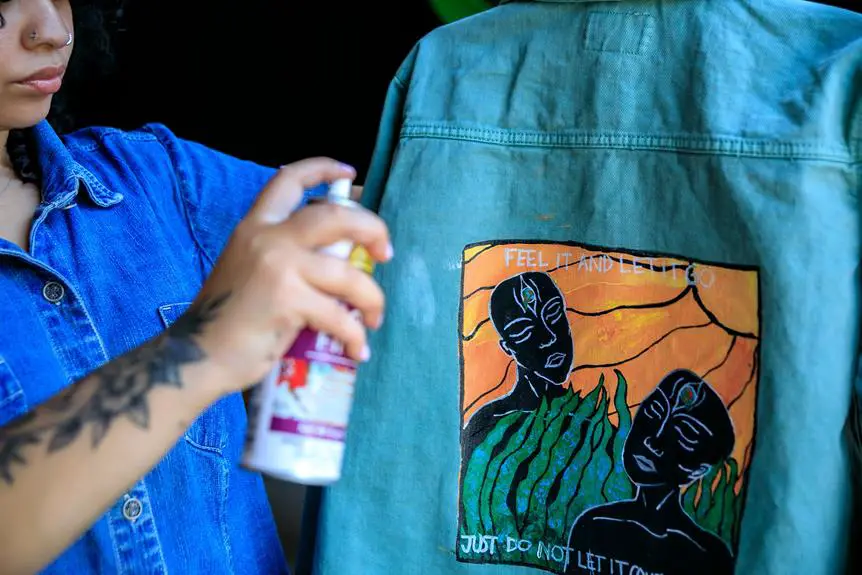Looking for the best spray fabric protector to keep your favorite sofa stain-free? You've come to the right place.
When it comes to safeguarding your fabrics, you want a product that delivers top-notch protection without compromising the look or feel. It's crucial to understand what sets the best spray fabric protectors apart, so you can make an informed choice.
With the right guidance, you can confidently select a protector that suits your specific needs and provides the mastery of protection you're looking for.
Let's explore the key factors to consider and compare the effectiveness of leading brands to ensure you make the best choice for your cherished fabrics.
Key Takeaways
- Spray fabric protectors create a barrier that repels liquid and prevents stains from setting into the fabric.
- Benefits of using spray fabric protectors include prolonging the life of fabrics, keeping them looking newer for longer, and making it easier to clean up spills and messes.
- Some potential drawbacks of spray fabric protectors include altering the feel or appearance of the fabric and the need for reapplication after cleaning.
- When choosing a spray fabric protector, it is important to consider the balance between durability and breathability, as well as the environmental impact and chemical effectiveness of the product.
Understanding Spray Fabric Protectors
When choosing a spray fabric protector, it's important to understand how these products work and what benefits they offer. Spray fabric protectors are designed to create a barrier that repels liquid and prevents stains from setting into the fabric. The benefits of using a spray fabric protector are clear: it prolongs the life of your fabrics, keeps them looking newer for longer, and makes it easier to clean up spills and messes. By creating a protective layer on the fabric, these products can also help prevent fading and discoloration caused by UV rays.
However, it's important to note that there are some potential drawbacks to using spray fabric protectors. Some products may alter the feel or appearance of the fabric, and they may need to be reapplied after cleaning. Additionally, some spray fabric protectors may contain chemicals that could be harmful to the environment or to individuals with sensitivities to certain ingredients.
Understanding these benefits and drawbacks is essential in making an informed decision about whether to use a spray fabric protector and which product to choose.
Factors to Consider When Choosing
When choosing a spray fabric protector, it's important to consider the balance between durability and breathability.
You'll want to weigh the benefits of long-lasting protection against the need for fabrics to remain breathable.
Additionally, consider the range of chemical and eco-friendly options available to suit your preferences and values.
Durability Vs. Breathability
When choosing a spray fabric protector, you should consider both durability and breathability in order to find the best option for your needs. These factors play a crucial role in determining the effectiveness and comfort of the fabric treatment.
Here are some key considerations to keep in mind:
- Durability: Look for a spray fabric protector that offers long-lasting protection without compromising the fabric's feel and appearance. Opt for products that provide excellent water resistance and can withstand multiple washes without losing effectiveness.
- Breathability: Ensure that the fabric protector maintains the breathability of the fabric, allowing air to pass through while repelling moisture. This is especially important for outdoor and activewear to prevent discomfort from trapped heat and sweat.
- Environmental Impact: Consider the environmental impact of the fabric protector. Choose products that are eco-friendly and don't contain harmful chemicals to minimize harm to the environment.
Chemical and Eco-Friendly Options
Consider the environmental impact of the fabric protector by opting for products that are eco-friendly and do not contain harmful chemicals. When choosing a fabric protector, it's important to weigh the chemical effectiveness against the potential harm to the environment. Here are some eco-friendly alternatives to consider:
| Eco-Friendly Fabric Protector | Chemical Effectiveness | Environmental Impact |
|---|---|---|
| Plant-based spray | High | Low |
| Water-based solution | Moderate | Minimal |
| Silicone-free protectant | High | Low |
Opting for eco-friendly fabric protectors not only helps to reduce harmful chemical exposure but also minimizes the impact on the environment. It's essential to strike a balance between chemical effectiveness and environmental responsibility when choosing a fabric protector.
Top Features to Look For
Where can you find fabric protectors that offer the best water and stain resistance for your specific needs? When choosing a spray fabric protector, it's essential to consider the top features that ensure optimal performance. Here are the key features to look for when comparing fabric protectors:
- Long-lasting Protection: Look for a fabric protector that provides long-lasting protection against water, oil, and stains. The longevity of the protection will save you time and effort in reapplying the product frequently.
- Versatile Application: Opt for a fabric protector that's suitable for a wide range of materials, including cotton, polyester, leather, suede, and more. A versatile protector will cater to your diverse fabric protection needs.
- Invisible and Odorless: Choose a fabric protector that dries invisible and odorless. This feature ensures that the original look, feel, and breathability of the fabric are preserved without any lingering chemical smell.
Comparing Effectiveness of Leading Brands
To evaluate the effectiveness of leading fabric protector brands, assess their performance across various fabric types and real-life usage scenarios.
When comparing the effectiveness of fabric protectors, it's essential to consider their ability to repel liquids and resist soiling on different materials such as cotton, wool, polyester, and silk. Look for in-depth brand analysis that delves into the specific strengths and weaknesses of each product.
Consider the effectiveness comparison of how well these fabric protectors guard against common stains like coffee, wine, and oil-based spills. Real-life usage scenarios should also be taken into account, including factors such as durability after washing, UV resistance, and the impact on fabric breathability.
A comprehensive evaluation of the effectiveness of leading fabric protector brands will enable you to make an informed decision based on your specific needs and the types of fabrics you commonly encounter. Remember, the best fabric protector for you may not be the same as for someone else, so it's crucial to weigh the effectiveness of each brand against your unique requirements.
Application and Usage Tips
When applying a fabric protector, ensure that the surface is clean and dry to maximize its effectiveness in repelling liquids and resisting soiling on various fabric types. Follow these application and usage tips to ensure the best results:
- Even Application: Spray the fabric protector evenly, holding the canister 6-8 inches away from the fabric. Avoid oversaturation, as this can lead to uneven protection and potential discoloration.
- Multiple Coats: For long-term effectiveness, consider applying multiple thin coats rather than one heavy coat. Allow each coat to dry completely before applying the next one.
- Maintenance Secrets: Regularly vacuum and spot clean your treated fabric to remove any dirt, dust, or spills. This will help maintain the protective barrier and ensure the fabric continues to repel liquids and resist soiling effectively.
Proper usage and maintenance of the fabric protector are essential for its long-term effectiveness. By following these application tips and maintenance secrets, you can ensure that your fabric remains well-protected and easy to maintain.
Making the Best Choice for Your Needs
You should consider your specific needs and priorities when choosing the best spray fabric protector for you. Factors such as the type of fabric you need to protect, the frequency of use, and your budget will all play a role in making the best choice. To help you make an informed decision, let's compare some popular spray fabric protectors based on their features and user experiences.
| Brand | Application | Longevity | Odor | Price |
|---|---|---|---|---|
| Brand A | Easy | Long-lasting | Minimal | $$$ |
| Brand B | Quick | Durable | None | $$ |
| Brand C | Versatile | Moderate | Mild | $ |
Product comparisons: Brand A offers long-lasting protection and ease of application, but it comes with a higher price tag. Brand B, on the other hand, provides quick and durable protection at a more affordable price. Brand C is known for its versatility and moderate longevity with a budget-friendly price point.
Consider user experiences when making your decision. Reading reviews and testimonies can offer valuable insights into the performance of each product. By weighing the features and user experiences, you can make the best choice for your specific needs.
Frequently Asked Questions
Are Spray Fabric Protectors Safe to Use on All Types of Fabric, Including Delicate or Vintage Textiles?
When using spray fabric protectors, it's essential to ensure they are safe for delicate or vintage textiles. Look for products that offer UV protection and moisture resistance to safeguard these fabrics without causing damage.
Can Spray Fabric Protectors Be Used on Outdoor Furniture and Cushions to Protect Against UV Damage and Moisture?
To protect outdoor furniture and cushions from UV damage and moisture, consider spray fabric protectors with outdoor durability. Proper application techniques ensure effective coverage and long-lasting protection, making it easier to maintain your outdoor textiles.
Do Spray Fabric Protectors Have Any Negative Effects on the Environment or on Indoor Air Quality?
Using spray fabric protectors may impact the environment and indoor air quality. Consider alternative options to minimize health concerns. Be mindful of potential environmental impact and seek eco-friendly products to protect fabrics without compromising air quality.
How Long Does the Protective Coating From a Spray Fabric Protector Typically Last Before Needing to Be Reapplied?
The protective coating from a spray fabric protector typically lasts for several months before needing reapplication. Its longevity depends on usage and exposure, but generally, it's effective and durable, requiring reapplication every few months for optimal performance.
Are There Any Specific Cleaning or Maintenance Instructions to Follow After Applying a Spray Fabric Protector to Ensure Its Effectiveness Over Time?
To maintain the effectiveness of a spray fabric protector, follow specific cleaning instructions and maintenance tips. Regularly spot clean and gently wash the fabric as needed. Avoid using harsh chemicals or abrasive cleaning methods to preserve the protective coating.
- Choosing the Right Fabrics for Babies - July 20, 2024
- Impact of Fabrics on Skin Health - July 20, 2024
- Benefits of Antimicrobial Fabrics - July 20, 2024






